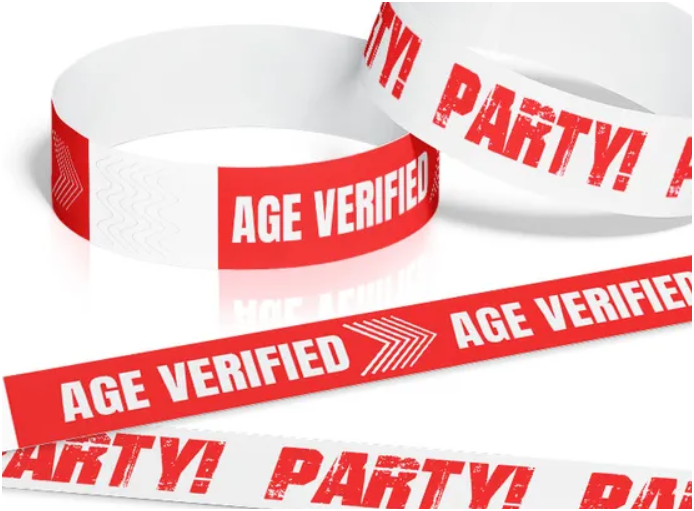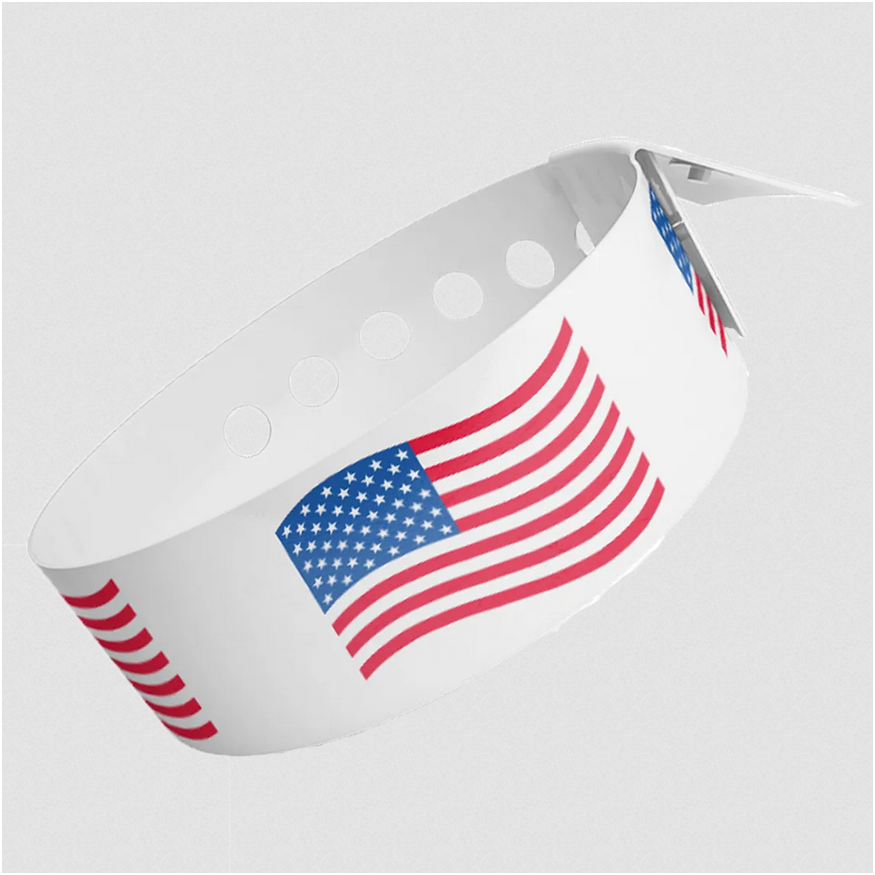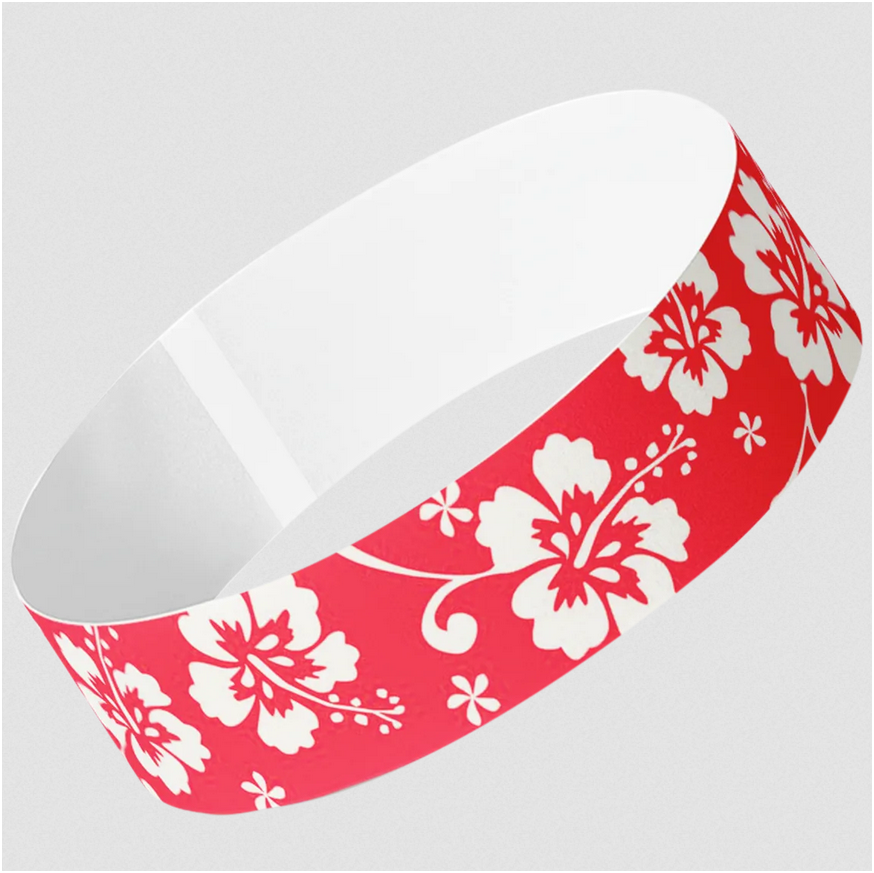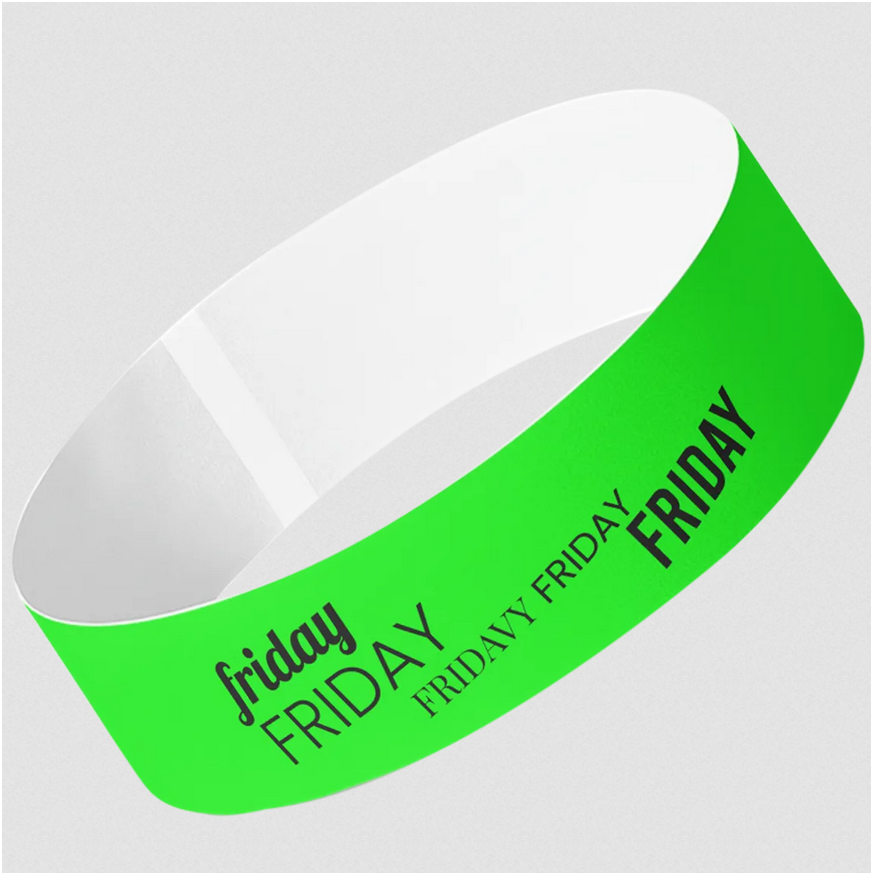Tyvek wristbands, made from polyethylene fibers, are widely used for event security and identification due to their durability and cost-effectiveness. As environmental concerns towards climate change grow, the recyclability of these wristbands has become a topic of interest.
This article aims to provide a comprehensive overview of Tyvek wristbands, their recyclability, and the environmental implications associated with their use.
The Innovation and Advantages of DuPont Tyvek Wristbands
Tyvek wristbands, developed by DuPont in 1967, are made from a flash-spun high-density polyethylene material called Tyvek. This synthetic material is prized for its lightweight durability, water resistance, breathability, and high tensile strength.
These qualities have made Tyvek wristbands popular for identification and security at events, festivals, and healthcare settings. Known for their tamper-proof design and wearer comfort, Tyvek wristbands remain a reliable solution.
Composition and Properties of Tyvek
Tyvek is primarily composed of high-density polyethylene (HDPE), a thermoplastic known for its outstanding strength and durability. HDPE fibers are formed through flash spinning into a nonwoven material with a paper-like texture that offers superior tear and puncture resistance.
These characteristics make Tyvek an ideal material for extensive wear, such as a band on the wrist. Meanwhile, Tyvek's water-resistant nature ensures that its sequentially numbered markers stay intact and readable, even when moisture like rain or sweat is exposed.
Despite its toughness, Tyvek remains lightweight, making it comfortable for users to wear over extended periods. Additionally, its breathability allows air and moisture vapor to pass through, reducing the risk of skin irritation.
This combination of durability, comfort, and functionality ensures that Tyvek is a trusted material for wristbands across various industries.
Applications of Tyvek Wristbands
Tyvek wristbands are widely used in various settings due to their unique properties:
- • Event Security: They are commonly used in concerts, festivals, and other large gatherings to manage crowd control and verify entry.
- • Healthcare: Hospitals use Tyvek wristbands for patient identification due to their durability and resistance to water and chemicals.
- • Recreational Facilities: Amusement parks, water parks, and sports events utilize Tyvek wristbands for access control and identification, especially with high-volume visitors such as students on school trips.
Advantages of Tyvek Wristbands
- • Cost-Efficient: Tyvek wristbands are relatively inexpensive to produce, making them a cost-effective solution for large-scale events.
- • Customizable: They can be easily printed with a business logo, text, and barcodes, allowing flexible customization to meet specific needs and ideas.
- • Tamper-Evident: Unlike other items, such as tickets, the wristbands are designed to show signs of tampering, which enhances security by preventing unauthorized transfers.
Exclusive Customized Event Tyvek Wristbands
Are Tyvek Wristbands Recyclable?
Tyvek, made from polyethylene (HDPE) fibers, is 100% recyclable. However, its specialized material composition cannot be placed in the standard curbside bin, making others believe it’s simply waste. Thankfully, there are proper ways of reusing these “disposable” Tyvek wristbands.
Some organizations partner with specialized programs to recycle Tyvek wristbands, offering solutions for waste materials not typically accepted in standard recycling systems.
Users can collect their used wristbands and send this waste through a recycling service designed for non-traditional materials, where the wristbands are processed and repurposed into new products.
Challenges in Reusing Tyvek Wristbands
- • Contamination: Inks, adhesives, and other waste contaminants can complicate the process. Ensuring that the wristbands are as clean as possible before sending them for waste reprocessing is crucial.
- • Limited Availability of Recycle Centers: Not all recycle-focused centers accept Tyvek materials, which can pose a challenge for individuals and organizations looking to recycle their wristbands. Identifying and utilizing specialized waste facilities is necessary.
- • Cost and Logistics: The shipping cost and logistics involved in sending Tyvek wristbands to recycle-focused centers can be a barrier for some users pushing for sustainability. Bulk collection and shipping can help mitigate these costs.
Recycling Tyvek wristbands is feasible and requires careful collection, cleaning, and shipping to recycle-oriented facilities. Individuals and organizations can contribute to sustainability efforts toward the waste management of Tyvek materials by participating in established sustainability programs and adhering to best practices.
Are There Eco-Friendly Alternatives to Tyvek Wristbands?

Although Tyvek is known for being durable, water resistant, and lightweight, its environmental impact has prompted the search for more sustainable–and, if possible, zero-waste–options. Several ideas for alternatives have emerged, each with distinct characteristics and benefits:
- • Biodegradable Paper Wristbands: Made from FSC-certified paper, fully reusable, and decomposes naturally. Suitable for short-term use.
- • Silicone Wristbands: They are sustainable alternatives to plastic, with many options from recycled silicone.
- • RPET Fabric Wristbands: These wristbands are crafted from recycled PET bottles, providing a durable option for multi-day business events while promoting sustainability efforts.
- • Compostable Wristbands: Break down in composting environments, which can further reduce landfill waste.
- • Bamboo Wristbands: Made from rapidly renewable bamboo, often combined with other materials for added durability.
Eco-friendly wristbands can be sourced from various suppliers specializing in sustainable products. When selecting a supplier, verifying the environmental claims and certifications associated with the wristbands is essential.
|
Minimize Use of Ink and Adhesives: When ordering Tyvek wristbands, opt for minimal ink usage to reduce contamination, which can simplify the reusing process. Alternatively, inquire about eco-friendly inks that are more recyclable and less environmentally harmful. While not zero-waste, this minimizes carbon footprint generation. |
Can You Recycle Tyvek Wristbands?
Tyvek wristbands, made from high-density polyethylene fibers, are designed primarily for single-use applications.
Their durability and resistance to water and tearing make them ideal for short-term use in various settings such as events, festivals, and hospitals. However, the reusability of Tyvek wristbands as a zero-waste solution is limited due to several factors:
Adhesive Integrity
Despite its paper-like build, the adhesive used on Tyvek wristbands is designed to create a secure bond when first applied. Once the wristband is removed, the adhesive loses effectiveness, making it difficult to reattach securely. This compromises the wristband's ability to function as intended in subsequent uses.
Structural Degradation
While Tyvek is known for its strength and durability, repeated bending, twisting, and exposure to environmental elements can cause the material to weaken. This degradation can lead to tears or fraying, reducing the wristband's overall integrity and making it unsuitable for reuse.
Hygiene Concerns
In settings where hygiene is paramount, such as hospitals or food service events, reusing wristbands poses a risk of cross-contamination. Even if the wristband appears intact, it may harbor bacteria or other pathogens that could be transferred to new users.
Security Features
Many Tyvek wristbands are equipped with tamper-evident features to prevent unauthorized transfer. These features are designed to show visible signs of tampering when the wristband is removed, thus ensuring that it cannot be reused without detection. This is particularly important in security-sensitive environments like concerts or amusement parks.
Given these factors, Tyvek wristbands are minimally reusable. They are engineered to provide a reliable, single-use solution that ensures security, durability, and hygiene and aims to reduce the need for bulkier and potentially more wasteful identification markers.
For applications requiring multiple uses, alternative materials such as silicone or fabric wristbands, which are designed for repeated wear and can be sanitized, may be more appropriate.
Top Tips for Reusing Tyvek Wristbands Effectively

In the pursuit of saving resources, it is essential to explore eco-friendly alternative ideas to use Tyvek wristbands. Aside from using eco-friendly alternatives for sustainability-conscious events, reusing Tyvek wristbands can effectively minimize waste and extend the product's lifecycle.
To reuse Tyvek wristbands effectively, follow these best practices:
- • Arts and Crafts: Frame event photos or decorate scrapbooks with wristbands. Attach them to items like lampshades, clocks, or wind chimes for a unique touch.
- • Educational Projects: Incorporate wristbands into school projects or art classes, encouraging students to get creative while learning about recycling and reusing materials.
- • Event Memorabilia: Keep wristbands as keepsakes from events, especially if they carry sentimental value or mark significant experiences.
- • Recycling Programs: Send used wristbands to companies collaborating with organizations to repurpose the material into new products.
- • Proper Disposal: When reuse isn’t possible, dispose of Tyvek wristbands through specialized sustainability and recycling programs instead of regular waste streams.
By creatively reusing Tyvek wristbands and engaging in recycling programs, you actively contribute to sustainability and reduce waste.
|
Encourage On-Site Collection for Recycling: If you're running an event, set up collection bins for Tyvek wristbands. This prevents them from ending up in the trash and streamlines the recycling process. Make it easy for participants to discard used wristbands into dedicated bins after the event. While Tyvek wristbands are not a zero-waste solution, we can at least ensure their proper transfer to the right reprocessing facilities. |
Choose Eco-Friendly and Durable Wristbands for Your Next Event
Tyvek wristbands, made from high-density polyethylene fibers, offer durability and waterproof properties, making them ideal for wrist-wear identification at various events.
While these wristbands are reusable, proper recycling methods are essential to realize their environmental benefits fully. Eco-friendly wristbands are an excellent alternative for those seeking more sustainable options.
Understanding the environmental impact, reusability, and customization options of Tyvek wristbands enables consumers to make informed decisions.
Reputable suppliers now offer greener options, contributing to a more sustainable future. Ready to make an eco-friendly choice? Explore custom Tyvek wristbands today!

/filters:quality(80)/fit-in/630x380/blog/image-1727307983.png)


